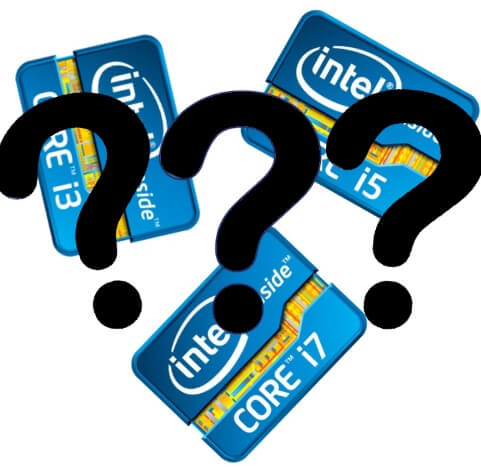After the announcement of the LGA1155 platform, Intel is methodically updating its processor lines. Starting with top-end CPUs, the manufacturer is moving to Sandy Bridge and more affordable solutions - Core i3 and Pentium. The latter are intended for entry-level and mid-level systems. Models costing “about $100” have always been objects of close attention from users who are accustomed to looking for optimal options when completing the system. Often people who choose a processor from this price category approach this issue even more responsibly than those who are willing to pay any price for maximum performance. Let's see what the new Intel products are capable of in comparison with their predecessors and alternative solutions from the main competitor.
Core i3
From a technical point of view, the most important difference between the Core i3 and the Core i5/i7 chips is that they are initially based on a dual-core crystal, and not a quad-core one with deactivated computing units. That is, no tricky tricks with unlocking will work here, however, Intel chips have not provided such an opportunity before. The area has decreased from 216 to 131 mm2, therefore, significantly more workpieces are obtained from one silicon wafer, and the cost of their production is lower. Accordingly, Intel has a chance to offer interesting retail prices, continuing to make money even on budget processors.
What changes have occurred in terms of functional equipment? The amount of L1 and L2 cache memory is identical for all models on Sandy Bridge (64 KB and 256 KB per core), but the third level buffer in the Core i3 has decreased in proportion to the number of cores - from 6 to 3 MB. The compact crystal, made using 32-nanometer technology, allows you to count on good power consumption indicators. The TDP for the second generation Core i3 is 65 W, while for predecessors from the Clarkdale family this parameter was within 73 W.
| 3DMark 06, CPU test, scores |
| System energy consumption, W |
 |
| PCMark 7, Computation scenario, points |
 |
| Fritz chess Benchmark 4.2, thousand nodes/c |
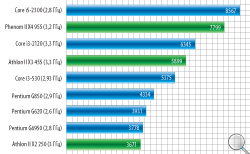 |
| x264 HD Benchmark 4.0, fps |
 |
| WinRAR 4.0, KB/s |
 |
| CineBench 11.5, points |
 |
| Resident Evil 5, 1920×1080, DX9, average quality, fps |
 |
| Colin McRae: DiRT 3, 1920×1080, medium quality, fps |
 |
| Far Cry 2, 1920×1080, medium quality, fps |
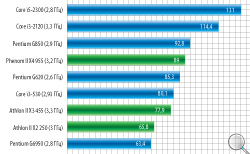 |
On-chip integrated Intel graphics HD Graphics 2000 with 6 computing units. The standard frequency of the video core is 850 MHz, while during operation it can dynamically increase to 1.1 GHz. Quick Sync support retained – powerful tool for video transcoding. The advantage of Core i3 is also its technology Hyper Threading, which adds a couple more virtual cores to two physical cores. IN multi-threaded applications This function sometimes plays a very important role, allowing you to use CPU resources more efficiently. We also note that the processor has the ability to execute instructions from the AVX (Advanced Vector Extensions) set, which, with the proper degree of optimization, will help speed up floating-point calculations, which are actively used in multimedia software.
Alas, Core i3 does not support Turbo Boost technology for dynamically increasing the frequency of processor cores, which is to some extent compensated for by high nominal values. Given the positioning of the CPUs of this family, there are also no AES encryption instructions here.
The current line of processors consists of four models. Junior Core i3-2100 with clock frequency 3.1 GHz is offered for $117. The Core i3-2120 operates at 3.3 GHz and costs $20 more. Intel has also included a cost-effective version of the i3-2100T with a TDP of 35 W. As a rule, it is possible to reduce CPU power consumption by reducing the operating clock frequency and supply voltage. On motherboards ah, allowing the user to independently perform downclocking and reduce the voltage below the recommended values, it is often possible to achieve similar results. But in cases where this is not possible, purchasing energy-efficient models will be justified. The Core i3-2100T operates at 2.5 GHz, and the graphics unit frequency is reduced from 850 to 650 MHz, while it can dynamically increase to 1.1 GHz.
Chips with reduced power consumption will be in demand for systems with compact housings, having a small volume and, accordingly, limited possibilities for choosing a cooling system.
The Core i3-2105 stands out in the series. This model has identical clock speeds to the i3-2100, but differs from other devices in the family in the use of more powerful Intel HD Graphics 3000 graphics. Returning to the topology of the crystal, we note that the graphics component occupies a significant part of it - about a quarter. In turn, the lion's share of space is allocated to computing units. Therefore, taking into account the fact that most budget models will have built-in HD Graphics 2000 with 6 blocks, not 12, Intel developers rightly considered that banal deactivation of half of the computers is not an entirely rational solution. Therefore, from a technological point of view, it turned out to be more profitable to have two designs of dual-core crystals. The version with more powerful graphics has a slightly larger area (149 mm2), but in terms of power consumption it also falls within 65 W. As we could see earlier, the performance of HD Graphics 2000 and 3000 is noticeably different: depending on the tasks, the latter is 1.5–2 times faster, while being a serious competitor to budget discrete video cards. An overpayment of $14 for a modification with faster graphics will make sense if you are determined to use integrated video, and the capabilities of HD Graphics 2000 seem insufficient for the intended tasks.
Unlike mobile solutions, where even dual-core processors can be offered under the Core i7 brand, among desktop Core models with Sandy Bridge architecture there is currently a fairly clear segmentation by the number of computing units (physical and virtual): Core i7 - 4 cores and Hyper Threading , Core i5 – 4 cores without HT, Core i3 – 2 cores and Hyper Threading.
Pentium
If we move down the conventional scale of differentiation of actual Intel processors, Core i3 is followed by Pentium chips. With the advent of the Core architecture, without exaggeration, the legendary brand was used to designate fairly affordable CPUs with traditionally good value price/performance. Modernization of this line has been asking for a long time. Recently, models for the still relevant LGA775 platform have not been easy to hold back the onslaught of inexpensive solutions from AMD, especially to compete on equal terms with the tri-core Athlon II X3, which at a similar price often offered more high performance. Pentium based on the Clarkdale core for the LGA1156 socket have not gained significant popularity. The market situation at the time of the release of this platform was such that it was primarily positioned by Intel as a solution for mid- and high-end systems. Therefore, even after expanding the initial range of processors, the minimum cost of admission here remained quite high. The retail price of the most affordable Pentium G6950 is about $100, which is a bit expensive for a PC entry level. It is easy to assume that Pentium for LGA1156, combining two crystals (CPU and GPU), has a higher cost. Therefore, it is quite difficult to seriously reduce the price of these processors. Moreover, in this case we are talking about budget chips of mass production. And boards cheaper than $80–90 for LGA1156 actually appeared only after the announcement of Sandy Bridge.
The updated Pentium modifications were the result of a simple simplification of the dual-core chips used for the Core i3. First of all, Pentium lost Hyper Threading technology, as well as the ability to execute AVX instructions. At the same time, the cache memory volumes are identical to those for the Core i3. The new Pentium family chips also use Intel HD Graphics 2000, although with a number of restrictions regarding support for proprietary technologies. In particular, Quick Sync, the Intel Clear Video HD visual enhancement function and stereoscopic image output (Intel InTru 3D) do not work here.
At the initial stage, the line includes four models: Pentium G850 (2.9 GHz), G840 (2.8), G620 (2.6 GHz) and G620T (2.2 GHz). As you might guess, the latter refers to economical modifications, the energy consumption level of which does not exceed 35 W. In addition to the clock frequency reduced to 2.2 GHz, like the energy-efficient Core i3-2100T model, it also has a reduced graphics core frequency to 650 MHz with a limit value of 1.1 GHz.
As you can see, the new Pentium processors, compared to the Core i3, are mainly lighter in terms of functionality, while the basic characteristics should provide a decent level of performance. The Sandy Bridge microarchitecture used promises a good increase in performance, which we will try to verify during practical tests. As for the price, in wholesale quantities the cost of the CPU family lies in the range of $64–86. The retail price will be slightly higher, but it is obvious that Pentium will be cheaper not only than the Core i3, but also its predecessors with the Clarkdale core.
The updated Pentium models were presented quite recently - at the end of May. And almost immediately they appeared in retail sales in Ukraine. Intel has good practice bringing their products to market when they become available to customers either simultaneously with the global presentation or as soon as possible after it.
| Model | Core i3-2120 | Core i3-530 | Pentium G620/G850 | Pentium G6950 | Athlon II X3 455 | Phenom II X4 955 |
| Codename | Sandy Bridge | Clarkdale | Sandy Bridge | Clarkdale | Rana | Deneb |
| Number of cores (threads), pcs. | 2 (4) | 2 (4) | 2 | 2 | 3 | 4 |
| Clock frequency, GHz | 3,3 | 2,93 | 2,6/2,9 | 2,8 | 3,3 | 3,2 |
| L3 cache size | 3 | 4 | 3 | 3 | – | 6 |
| Integrated graphics (core frequency) | Intel HD Graphics 2000 (850/1100) | Intel HD Graphics (733) | Intel HD Graphics 2000 (850/1100) | Intel HD Graphics (533) | – | – |
| Technology production, nm | 32 | 32 + 45 | 32 | 32 + 45 | 45 | 45 |
| CPU socket | LGA 1155 | LGA 1156 | LGA 1155 | LGA 1156 | AM3 | AM3 |
| Power consumption (TDP), W | 65 | 73 | 65 | 73 | 95 | 125 |
| Recommended price, $ | 138 | ~105* | 64 | 87 | 76 | 117 |
| * According to the Hotline.ua catalog | ||||||
Overclocking
Overclocking is a fairly popular pastime for many enthusiasts. Someone is trying to increase system performance in this way in the hope of delaying the next upgrade. For some, it is a hobby, a sport, or a way to satisfy idle curiosity by exploring the capabilities and hidden potential of the CPU.
Unfortunately, those who like to experiment with overclocking will be a little disappointed this time. Considering the specifics of the clock generator operation in new platform and the processor multiplier of the considered chips is locked, it is obvious that the room for maneuver here is seriously limited. Even despite the relatively high multiplication factors (+100–150 MHz), this is all that can be squeezed out after increasing the carrier bus to 103–106 MHz, at which current motherboards maintain stable operation. Of course, these are not the indicators that we would like to get, especially considering that older Sandy Bridge models often reach frequencies of 4500 MHz and higher even in the air. Alas, the new Pentium and Core i3 are not designed for overclocking at all. You will have to come to terms with this fact and take it into account when purchasing. At the same time, it is also important not to forget that these chips, even in normal mode, are noticeably more productive than their predecessors, which can even out the difference in frequencies.
In our opinion, you can’t expect modifications with unlocked multipliers among Core i3 and Pentium. Models with the K index, so beloved by overclockers, will be available only in the more expensive Core i5/i7 lines.
Results
As the test results demonstrate, the new Intel processors in the mid-price category have a noticeable performance advantage over their predecessors in terms of performance. Under conditions of good multi-threaded program optimization, AMD chips with big amount physical computing units can sometimes provide serious resistance. For example, if you look at the performance of the Athlon II X3 455 and Pentium G620, which are now offered at approximately the same price, then a triple-core CPU in applications where calculations can take place in parallel has a definite advantage. Even though the core speed in terms of megahertz of AMD products with K10.5 architecture is noticeably lower than that of Intel chips on Sandy Bridge, in such software “brute force” is often quite effective, although this is achieved by increasing energy costs by one and a half times. However, we must admit that this is an ideal case when all processor cores are used as efficiently as possible. In real applications, this does not happen often, unfortunately. In games, new Intel solutions have unconditional superiority. As we have already seen, the Sandy Bridge microarchitecture copes well with such loads, and the gap between both its predecessors and competitor models is maximum.
New Pentiums are on average 20% more productive than CPUs of the same name for LGA1156 and compete almost equally with Core i3 on the Clarkdale core, which are noticeably more expensive. Simplification of the functional part of these chips did not greatly affect their speed performance. Therefore, these models can be fully recommended for creating universal systems and entry-level gaming platforms. In turn, the second generation Core i3 also noticeably accelerated. Of course, with Quad Core It is difficult for them to compete with i5, but high clock speeds and support for Hyper Threading technology allow them to demonstrate very decent results, including in applications with multi-threaded optimization. Well, in games they sometimes look preferable to the quad-core AMD Phenom II X4. Considering that these processors have retained the functionality of older models, they may be interesting for creating both mid-level gaming PCs and powerful multimedia systems.
This time, Intel has done everything to make the LGA1155 platform truly universal. The existing infrastructure allows you to create both a top-end system and an inexpensive entry-level PC. For powerful configurations, there are enough motherboards on the market based on Intel Z68 and P67 chips, and for the most affordable solutions, it is quite possible to use models based on Intel H61. Intel's processor line now looks very smooth. There are no distortions or obvious competition between solutions from different families. So far, one brick is missing - the most affordable CPU models. Soon, Celeron is also planned to be transferred to the 32-nanometer process and a progressive microarchitecture. Presumably, these chips will appear in the third quarter of this year, at which time the range of other lines on Sandy Bridge will be expanded.
| Inno3D | Inno3D, www.inno3d.com |
| Intel | Intel, www.intel.ua |
04.09.2013
Intel continues to systematically transfer all its processors to the new Haswell core. We welcome you with the flagship Intel Core i7-4770K, and now it’s the turn of much more mundane solutions - the dual-core Core i3-4340 and Pentium G3430, which will go on sale in the near future. Looking ahead, we note that this couple has something to surprise the buyer.
Judging by reviews, discussions on numerous forums and groups social networks, then the most popular processors on the market were, are and remain Core i7 and Core i5 processors. These are the ones we talk about most often. But statistics say the opposite - Celeron, Pentium and Core i3 processors are noticeably more popular than their older comrades. And this is explained not so much by the affordable price, but by the fact that these processors are able to cover all needs modern users in computing power. Therefore, we could not miss the opportunity and not get acquainted with the latest Core i3-4340 and Pentium G3430 - the latest processors Intel on the Haswell core, and the fastest models in their own lines.
We will not study in depth the architecture of the processors included in our test laboratory, since in their internal structure they are completely similar to the already mentioned Core i7 on the Haswell core. The differences between the flagship i7 and the affordable Core i3 and Pentium are traditionally not qualitative, but quantitative. That is, there is no difference in organization, but the number of cores and cache sizes are different. And of course, more affordable models lack support for some technologies, which allows Intel to more accurately position its processors of different lines on the market. To avoid confusion, let's take a look at each of the new products separately.
Core i3-4340
The principle of dividing processors into five lines, adopted by Intel several years ago, turned out to be extremely successful, not only from a business point of view, but also from a technical one. In this line, Core i3 is a mid-price solution. With the advent of Haswell, nothing has changed in this regard. And the characteristics of the new Core i3, which received the model number 43xx, are basically similar to those we saw in Core i3 processors based on Ivy Bridge and Sandy Bridge cores.

To simplify everything as much as possible, then Core i3 is “half” of the flagship Core i7. There are 2 processor cores, which, thanks to the support of Hyper-Threading technology, are capable of processing 4 parallel data streams. The volumes of the first and second level caches are the same for all Haswell processors– 64 and 256 kilobytes per core. The third level cache of the Core i3 is 4 megabytes - again, exactly half that of the Core i7.
But unlike the older model, Core i3 processors do not support Turbo Boost technology, that is, they cannot automatically increase the clock frequency of one of the processor cores if the second one is idle. In principle, its absence is not critical for dual-core models.
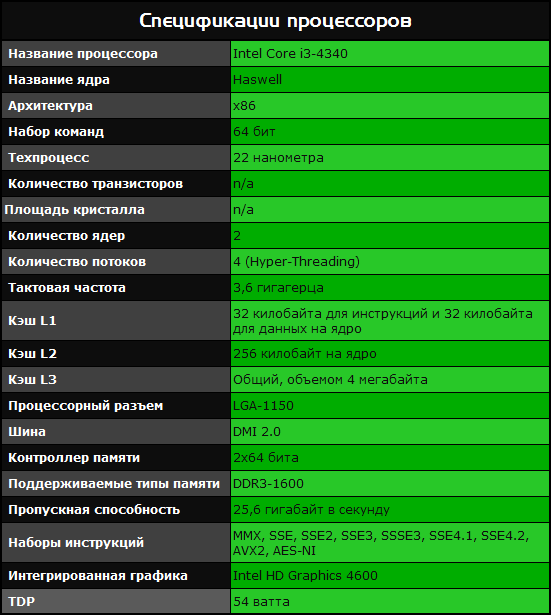
But the Core i3, of course, can reduce the frequency in case of downtime, like other modern Intel processors. Although, for modern processors support for this technology is no longer as critical as for the memorable Pentium 4, because the maximum power consumption of even the fastest Core i3 models does not exceed 54 watts! Very modest appetite! By the way, the previous generation Core i3 has a TDP of 55 watts. Against the backdrop of the increased appetite for the new Core i7 and Core i5, such efficiency of the Core i3 is somewhat surprising, because part of the power subsystem was also migrated to its crystal, and in addition it received a new graphics core.
The Core i3 graphics on the Haswell core are definitely pleasing. Instead of offering as before different versions this processor with different types graphics subsystem, in the new generation all i3 are equal in this regard. And not only among themselves, but also with quad-core Core i5 and Core i7, since all these solutions use the quite powerful Intel HD Graphics 4600, to which we dedicated.

It should also be mentioned that Core i3 processors received support for two new sets of streaming extensions - AES-NI and AVX2, which were not available in the previous generation models of this line. But the supported memory frequency has not changed – a maximum of 1600 megahertz. And of course only DDR3. However, as we know from personal experience, this frequency can be exceeded without any risk.
So, you have already formed a general opinion about the entire Core i3 line based on the Haswell core. It only remains to clarify that we were not acquainted with a production model, but with an engineering sample, which, in principle, has no of great importance. In fact, the sample that visited our test laboratory repeats the characteristics of the Core i3-4340, which is the fastest of all Haswell-based Core i3s thanks to a clock speed of 3.6 gigahertz.
Intel Pentium G3430
Don't be confused by the fact that the model number of this processor begins with the number 3, by which we are accustomed to identifying solutions based on the Ivy Bridge core. Like the Core i3-4340, the Pentium G3430 is a full-fledged representative of the 4th generation of Core processors. Or rather, their budget version, which is designed to increase the level of performance in the “up to $100” segment.

If Core i3, as we have already said, is half of Core i7, then Pentium is half of Core i5. Here, like the i3, there are two computing cores, but there is no support for Hyper-Threading technology, which automatically makes the Pentium much less attractive in terms of performance. After all, in this moment a significant number of applications and games use more than two data streams, which the Core i3 copes with much better than the “dual-threaded” Pentium thanks to HT. However, we will talk about this later when summing up the test results.
The volumes of the first and second level caches are again the same as those of other Haswells, but the L3 of the Pentium is one megabyte less than that of the Core i3 - 3 megabytes. This, by the way, is again two times lower than that of Core i5. However, this is not as big a loss as Hyper-Threading and will not have such a significant impact on performance. Naturally, there is no support for Turbo Boost either.
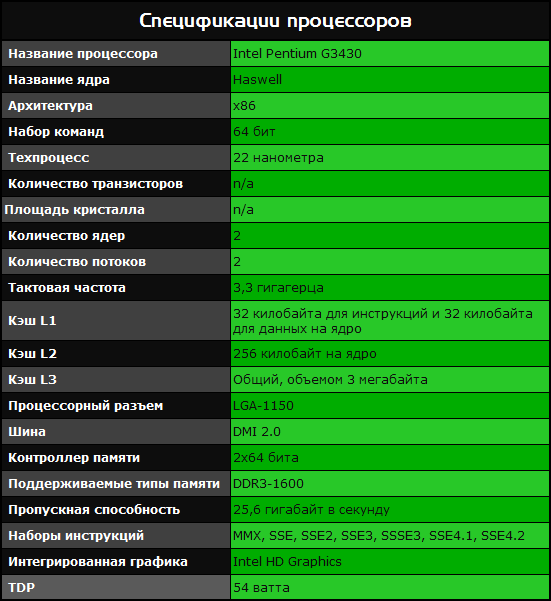
Intel set the Pentium processors to have exactly the same TDP as the Core i3 - 54 watts. But these are just numbers. We assume that the i3 will be able to reach this figure, but the Pentium in reality should be more economical. And there are reasons for this: a smaller cache and noticeably simpler graphics.
If you were waiting for the Pentium to appear on the Haswell core, hoping to buy yourself an inexpensive processor with sufficiently powerful graphics, you will be disappointed. Under the name Intel HD Graphics, without any digital designation, only half of the HD 4600 is hidden, which is used in all older models for desktop computers. That is, not 20, but 10 functional units, or, if you like, 40 stream processors. However, compared to Pentium processors based on the Ivy Bridge core, this is very good, because they used an HD 2500 with six blocks and approximately the same clock frequency. The only pity is that there is no support for Intel Quick Sync in Intel HD Graphics.
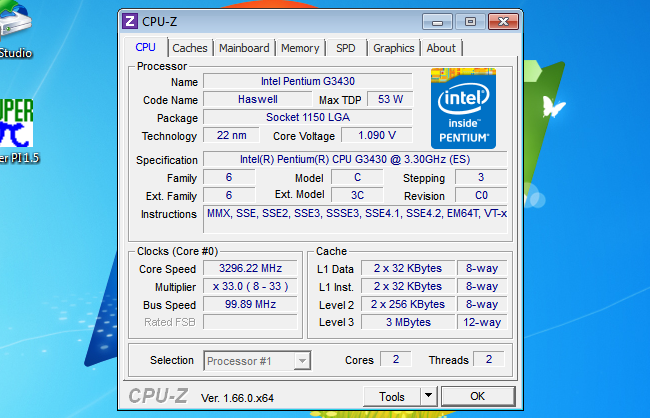
The new Pentiums do not support AVX and AES-NI streaming extensions. This is not surprising, given that in this generation they first appeared in the more expensive Core i3. The maximum memory frequency has remained unchanged from the previous generation - the same 1600 megahertz. Although in our case we had to use a lower frequency - 1333 megahertz, since the sample that visited our test laboratory did not want to work with RAM at the formally nominal frequency of 1600 megahertz.
The reason for such fastidiousness may be hidden in the fact that the new Pentium on the Haswell core, as well as the Core i3, was an engineering sample. Its characteristics are similar to the Intel Pentium G3430 model, that is, again, fastest processor in the new generation Pentium line, with a clock frequency of 3.3 gigahertz.
Tests
Well, we’ve already gotten acquainted with the processors, which means it’s time to check how the new products will perform “in battle”. As objects for comparison of the new Core i3-4340 (3.6 GHz) and Pentium G3430 (3.3 GHz), we chose the Core i3-3225 (3.3 GHz) and Pentium G2120 (3.1 GHz), based on Ivy Bridge kernel, that is, they are similar solutions, but of the previous generation.
We did not conduct graphics tests this time, focusing our attention on processor performance. If you are interested in the capabilities of the Intel HD Graphics 4600, then you can check out our test. We also note that processors operate at different frequencies, and this also needs to be kept in mind, although we will try to clarify this point in the comments to the results. Well, don’t forget about the difference in frequency random access memory. For Core i3 it is equal to 1600 megahertz, and Pentium is content with 1333 megahertz.
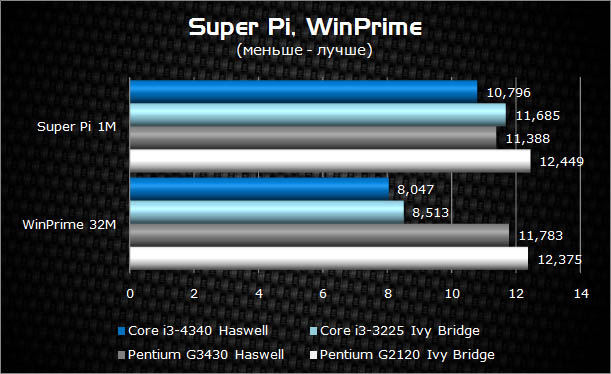
The simplest tests of Super Pi and WinPrime have always been in a great way check the pure performance of processor cores. As can be seen in the graphs, the Core i3-4340 outperformed its predecessor quite noticeably in both tests. But something else is much more interesting: in the Super Pi test, the new Pentium G3430 outperformed not only the Pentium G2120, but also the Core i3-3225! This is a clear confirmation of the higher efficiency of Haswell compared to Ivy Bridge.
WinPrime, which supports Hyper-Threading, has no longer allowed such pranks, and the difference between Core processors i3 and Pentium turned out to be very large. Within the pairs, the situation is predictable - processors based on the Haswell core are ahead of their rivals.

The ALU test block from the AIDA 64 complex has very interesting results. Thanks to HT support, the CPU Queen test noticeably distanced processors from different lines from each other. The situation within the pairs remains unchanged; the Core i3-4340 and Pentium G3430 are ahead of their predecessors. In the PhotoWorxx test, the difference between processors based on Haswell and Ivy Bridge increases, but the gap between Core i3 and Pentium, on the contrary, decreases greatly. If they worked at the same memory frequency, there is a high probability that the Pentium G3430 would again be able to outperform the Core i3-3225. The AES test results are surprising, but only at first glance. The Core i3-4340 is the only processor in the test with AES-NI support, and therefore its 16-fold superiority over its predecessor should not be surprising. However, the results of the new Pentium also look good compared to its predecessor.

FPU tests from the same test suite again show fairly linear and expected results. The new Core i3 and Pentium on the Haswell core are good compared to their predecessors in two out of three tests, and in the FPU Mandel Pentium G3430 again fell just short of the similarly clocked Core i3-2125. But the FPU SinJulia test clearly does not like 4th generation Intel Core processors; again, as in the flagship test, this test gave the new products a worse result than their predecessors. Strange.

As for the speed of working with memory, here again there is an analogy with the Core i7-4770K test. The Core i3-4340 and Pentium G3430 are superior to processors based on the Ivy Bridge core in terms of speed of reading and writing data to memory. But the speed of copying data in memory, like that of the flagship processor, has become lower.
Cinebench, as always, is clear. He clearly ranked the processors, as Intel intended. The advantage of the new Core i3 and Pentium over the old ones in this test was 12.4 and 9.5 percent, which is more than the difference in their frequencies. Even though Haswell still brought a small increase in pure performance per clock.
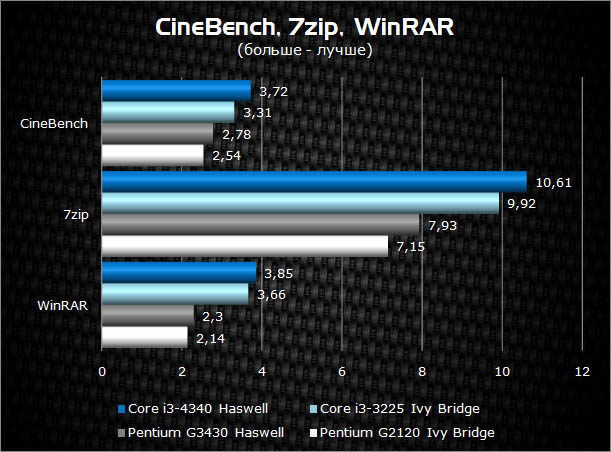
Surprisingly, a couple of archivers represented by 7zip and WinRAR, which were not delighted with the older Core i7-4770K, in the test of more modest solutions, rated the new architecture as it should be. Apparently, the smaller number of simultaneously processed threads played a role here, which emphasized the increased performance per clock that the Haswell core provided.
The 3DMark Cloud Gate physics test does not contain test results for the new Pentium G3430, since at the time of testing, drivers for its Intel HD Graphics were not available. However, this will not prevent us from assessing the potential of Haswell, using the example of the Core i3-4340, which confidently outperformed the Core i3-3225 by 9.6 percent. And this is a fairly decent increase for this test.
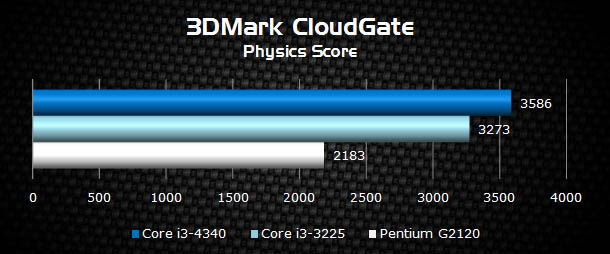
Well, to top off the test part, let's check how our test subjects are doing with thermal characteristics, especially since the top models this parameter not impressed at all. During the tests, the temperature in the room was 27-28 degrees, but despite this, at rest, all four processors remained within 29-31 degrees. Surprisingly, the Core i3-4340 turned out to be the coldest, although only by 1-2 degrees.
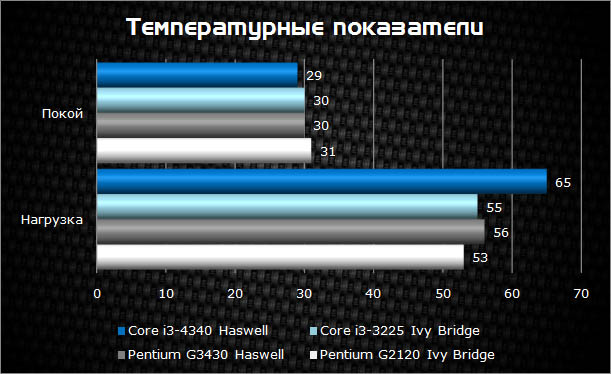
But in the load test the situation changed dramatically, and the coldest became the hottest. Largely due to the high test frequency, the Core i3-4340 heated up to 65 degrees. At the same time, the Pentium G3430, despite the fact that it uses the same core, heated up to only 56. But this is still slightly more than the Core i3-3225 on the Ivy Bridge core. Well, the best was the slowest chip – Pentium G2120. The impact of the transfer of part of the processor power circuits to the chip, which occurred in this generation, is obvious. However, there is no doubt that the overall energy consumption of the system, as well as heat generation, have become lower.
conclusions
The new Core i3-4340 and Pentium G3430, by and large, did not surprise us at all. They remain the same affordable processors with excellent performance for their price range. The transition to a new core brought minor changes and had virtually no effect on the overall balance of power. The Pentium G3430 will once again attract buyers with its affordable price and low heat dissipation, and even in the new generation these will be its main advantages, with slightly higher performance than its predecessor.
The Core i3-4340, as well as all processors of the new 4th generation Core i3 line, received much more than their younger brothers. First of all, it is worth noting the emergence of a new generation integrated graphics core – Intel HD Graphics 4600, which will be used in almost all i3 processors based on the Haswell core. And this is not only a noticeable increase in gaming performance, but also a new and improved Quick Sync, which works great with video with Ultra HD resolution, and can significantly reduce transcoding time.
Based on all of the above, and adding that the price of the new products will be approximately at the level of processors of the previous generation, we can draw an unambiguous conclusion. If you already have a computer based on a previous generation Intel Core i3 and Intel Pentium processor, then there is no point in upgrading. The current increase is not worth it. But if you are preparing to collect new computer, then you should turn your attention to the new Core i3 and Pentium. Even if not by much, they are clearly better than their predecessors. This is especially true for the Core i3, which, to be honest, we really liked.
Intel is deservedly one of the best manufacturers computer components. She is responsible for many new developments in the computer industry, successful models stationary and mobile processors, built-in video cards. Let's look at entry-level Intel processors, find out what the difference is between the Celeron Pentium Core-i3, and consider their features and distinctive features. The choice of an expensive, premium processor is not always justified and will provide you with all the advantages of using it.

All new processors, like most old ones, have two real computing cores in their arsenal. Each is built on the most new architecture for its year, which provides high performance in a small size and low power consumption. Most have enough supply for everyday tasks. The use of new developments allows you to achieve noticeably better performance in programs and games, unlike AMD processors.
Built-in Intel video card HD is capable of running many popular games on minimum settings and easily plays video in high resolution, plus, it consumes a small amount of electricity, which makes it economical. Like any integrated video cards, it requires a good supply of RAM, which is used to expand its own RAM.
Own development Intel- Hyper-threading. The technology allows you to send two threads to one core to increase the performance and response speed of programs and interfaces. The use of this technology made it possible to increase processor performance by 20%, without increasing its size and maintaining the same power consumption.
Why should you buy Intel:
- Low power consumption
- Fast and economical integrated video card
- Good support from game and application manufacturers
- Long service life and time of relevance of models
- High performance and low heat generation
Difference between Celeron, Pentium, Core-i3

Celeron is the most budget model of Intel processors. Celeron differs from Pentium in its lower cache memory size, lower operating frequency of each core and low bus frequency. The processor is designed for low-cost laptops and personal computers, whose main goal is work, films and music. It is not able to run modern games at high settings in Full HD resolution, even when paired with a good video card.
More expensive budget processor Pentium has a good supply of second-level cache memory, and in some cases third-level memory is also available. It contains 2 or 4 cores with high frequency work. The main difference between Pentium and Core i3 is the lack of Hyper-threading technology. Performance is enough to run modern games on maximum settings in high resolution.
Core i3 is the first of Intel's premium processors. It has two physical cores, but with the help of Hyper-threading it can execute 2 threads at once with one core. Many models of this processor come with a built-in graphics core, the performance of which is higher than that of analogues installed in Celeron or Pentium. If you have a good video card, it copes with super games. high resolution. There is no real, huge difference between Core i3 and Pentium, i3 performance is about 10-15% higher.
If you choose then you better choose Pentium processor with a high-quality discrete video card, rather than a Core i3 with a cheaper graphics core.
Now you know the difference between Celeron, Pentium, Core-i3. If you have any questions, feel free to ask in the comments or in a special section of the site.
Related posts:
